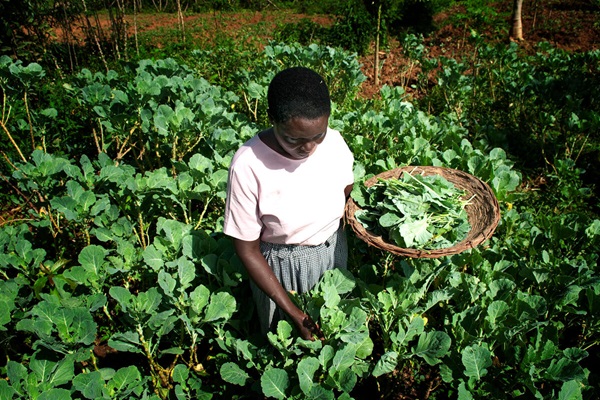
Rome- There is an urgent need to transform agrifood systems and leverage their climate solutions, the Food and Agriculture Organization of the United Nations (FAO) has said in light of the findings of the latest UN State of the Global Climate Report.
The World Meteorological Organization-(WMO)-led report in collaboration with other UN agencies including FAO, shows how climate change indicators records including surface temperatures and greenhouse gas levels were once again broken in 2023. It also brings light on how extreme weather events are progressively affecting food security and agriculture, with wider socio-economic implications.
“The latest WMO report is a chilling reminder of runaway climate change and its impacts, including on food insecurity. Reversing this trend will require major investments in solutions that can help countries and communities build resilience to a changing climate, reduce record-breaking emissions and protect lives and livelihoods all at once. Nowhere are these solutions more abundant and impactful than in agriculture and food systems”, said Kaveh Zahedi, Director of the FAO Office of Climate Change, Biodiversity and Environment.
Climate impacts on food and agriculture
According to the report, heatwaves, floods, droughts, wildfires and rapidly intensifying tropical cyclones caused misery and mayhem in 2023, upending every-day life for millions and inflicting many billions of dollars in economic losses.
The report, with contributions from FAO's Climate Risks team, underscores ongoing concerns regarding food security, population displacements, and vulnerabilities, particularly exacerbated by extreme weather events. It notes a stark increase in acute food insecurity, with the number of affected people more than doubling since the pre-COVID-19 era, as noted in the latest FAO’s State of Food Security and Agriculture.
The publication also identifies various underlying factors contributing to food insecurity, including prolonged conflicts, economic downturns, high food prices, and climate-related impacts. Regional examples further illustrate these challenges. For instance, southern Africa grappled with severe flooding triggered by Cyclone Freddy, causing extensive damage to agricultural lands and impeding economic recovery.
Similarly, South Sudan faced prolonged flooding, exacerbating food insecurity and straining access to basic necessities for millions. In Indonesia, meteorological drought linked to climate phenomena led to significant crop failures and reduced rice production, highlighting the global economic losses attributed to climate-related disasters, particularly droughts.
The report emphasizes the agricultural sector's vulnerability to climate-related risks, with drought posing the most significant threat, accounting for a substantial portion of damage and loss globally. These findings underscore the urgent need for comprehensive and coordinated efforts to address climate change impacts, mitigate risks, and build resilience within vulnerable communities worldwide.
FAO’s work on Climate
FAO is actively implementing some of the recommendations outlined in the report, particularly in enhancing climate resilience and adaptation within the agrifood sector. The Organization also promotes climate action as a crucial opportunity to ensure agrifood solutions are fully integrated into the environment and climate agenda.
The FAO Strategy on Climate Change and its Action Plan take a comprehensive approach, considering various sectors such as crops and livestock production, forestry, fisheries, and aquaculture, along with related value chains, livelihoods, biodiversity, water and ecosystems. It acknowledges the crucial roles of women, youth, and Indigenous Peoples in driving change.
This strategy is flexible, addressing diverse contexts like rural, peri-urban, and urban areas. It assists countries in aligning their agrifood systems with their national climate commitments and policies, including Nationally Determined Contributions (NDCs), National Biodiversity Strategies and Action Plans (NBSAPs) and Land Degradation Neutrality (LDN) targets.
Furthermore, FAO's strategy assesses different risks, including the consequences of inaction, systemic risks, and environmental risks. It tailors interventions to the specific needs of vulnerable populations and integrates climate risk management across FAO's work domains.
As a delivery partner for the Green Climate Fund (GCF), FAO also supports low and middle-income countries in realizing their climate objectives. Collaborating since 2016, FAO and GCF have significantly increased investments in projects enhancing the efficiency, inclusivity, sustainability, and resilience of agriculture, forestry, and fisheries sectors to climate change, with a portfolio surpassing 1 billion.
Similarly, as a partner agency for the Global Environment Facility (GEF), FAO supports countries worldwide in addressing the complex challenges at the nexus between the agrifood systems and the environment. FAO’s global GEF portfolio currently exceeds USD 1.4 billion, assisting more than 120 countries in projects that respond to local priorities, deliver global environmental benefits, and advance the Sustainable Development Goals (SDGs).
FAO's initiatives like SAGA and SCALA focus on implementing climate solutions in vulnerable regions. Moreover, FAO anticipates and responds to threats posed by extreme weather events, utilizing early warning systems and providing resources for anticipatory action.
Notably, the Kunming-Montreal Global Biodiversity Framework and the UNFCCC COP28 outcomes, particularly the Global Stocktake and the Global Goal on Adaptation, make a clear acknowledgement of the importance of agriculture and food systems.
“This provides us with the opening for a more joined-up and coherent approach across the Rio Conventions, in the context of nature preservation, climate action and food security. Now is the time to advocate together the solutions within agrifood systems that can simultaneously address environment, biodiversity, climate, and of course food security challenges”, adds Zahedi.